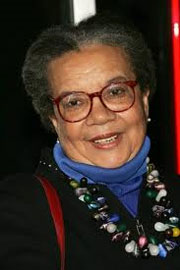
Child Watch
“Mama, get me away from around here!”
By Marian Wright Edelman NNPA Columnist
Today, almost one year after I first wrote about Ka’nard Allen, his story—and the stories of several other children whose lives are connected to his—remains a searing example of how pervasive gun violence in our nation’s cities is killing, injuring, and traumatizing our children.
On May 29, 2012, Ka’nard celebrated his 10th birthday at his grandmother’s house in the Central City neighborhood of New Orleans. He and his friends and family members were playing games in the front yard and on the porch. “We was having a party and then it’s a shooting,” Ka’nard said. Four young men carrying guns and an AK-47 ran up and unleashed a volley of bullets. Police said they were attempting to kill members of a rival group at or near the party. Ka’nard felt the sting as he was struck in the calf and on the side of his neck.
His mother, Tynia Allen, saw blood running down his neck. To get help she had to step over Ka’nard’s five-year-old cousin Brianna Allen’s lifeless body on the porch. The reach and po-wer of the assault rifle was so great that a bullet fired near the party also struck and killed Shawanna Pierce, 33, in her car at a stop sign three blocks away, leaving three young boys without a mother.
That year, along with many before it, New Orleans had one of the highest per capita murder rates of any city in America—close to 95 percent of them committed with guns. The carnage at Ka’nard’s party, as well as at other shootings before and since, sent out waves of fear, grief and anger that linger on in the lives of the children a-fected.
Shawanna Pierce’s youngest son, now three, doesn’t remember his mot-her. But her two older boys, Kelby, now 12, and Kolby, eight, began to cry when asked about their mother. Their maternal grandmother, still deeply grieving herself, asked them to recall things they did with their mother, who worked in the coding department of a local hospital. Disney World, she prompted, the zoo, the Ponchatoula Strawberry Festival. “I can’t,” Kelby said. “I’m too sad.” Both boys have photos of their mother on their cell phone cases. Their grades suffered, although now, almost two years later, the boys’ school work is beginning to improve.
Less than a year after he was shot at his birthday party, he was shot again—in the cheek—when he and his mother went to a Mother’s Day parade last May. Two gunmen fired into the crowd, wounding 19 people, including Ka’nard and a 10-year-old girl.
“He panicked,” his mother said. “He said, ‘Mama, get me away from around here!’”
That could be the cry of every child and teenager growing up in a violent neighborhood.
Some never have the chance to grow up. In the last six months of 2013 in New Orleans, a one-year-old girl was shot to death on the street in the arms of a babysitter, an 11-year-old girl was killed in bed by stray bullets entering her home, and a seven-month-old boy was shot in the head while riding in a car with his father.
Even children who are not directly hit by gun violence suffer the collateral damage of living in an unsafe environment saturated with guns that are routinely used to settle conflicts or to exact retaliation. A striking number of low income children in New Orleans have witnessed gun violence and murders, according to a 2011-2012 screening of children between the ages of 11 and 15 who participated in a teen pregnancy prevention program. Of the 700 interviewed by the Institute of Women and Ethnic Studies, 29 percent had witnessed assaults with guns; 14 percent had witnessed gun homicides. More than half cited concern about “personal safety” as a source of worry, more than twice the number who worried about “being unloved.”
The Children’s Bureau of New Orleans, a non-profit agency that offers mental health counseling, runs a program called Project LAST—the Loss And Survival Team—that works with some of the city’s children who have had multiple exposures to gun violence. “They’ve had loved ones murdered by guns, they’ve seen people carrying guns, they’ve been threatened by guns, they’ve seen a dead body in the street—three or four different exposures to gun violence,” said its president and CEO Paulette Carter.
Ka’nard still sees a psychologist because “I get mad real fast,” he said. His mother said he doesn’t like to go places by himself. But he attends a school he likes, has a mentor, has taken trips thanks to a local foundation, and plays drums in his school’s band. This year he was looking forward to marching in some of the city’s Mardi Gras parades—an event that should be a simple childhood pleasure, but one Ka’nard, like so many of our nation’s children, can no longer take for granted.



Be the first to comment